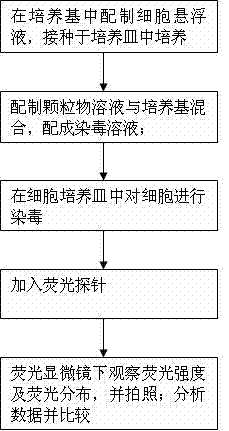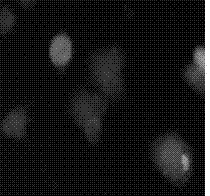Method for detecting difference of cell toxicity between atmospheric nano particles and industrial nano particles
A nanoparticle and cytotoxic technology, applied in biochemical equipment and methods, microbiological measurement/testing, fluorescence/phosphorescence, etc., can solve the problems of low accuracy, many influencing factors, carcinogenicity, etc., and achieve less influencing factors , accurate results, and easy to purchase
- Summary
- Abstract
- Description
- Claims
- Application Information
AI Technical Summary
Problems solved by technology
Method used
Image
Examples
Embodiment 1
[0029] Such as figure 1 As shown, a method for detecting the cytotoxicity difference of atmospheric nanoparticles and industrial nanoparticles, its operation sequence and steps are as follows:
[0030] a. Aspirate the cells digested with trypsin into a centrifuge tube, discard the supernatant, and add 10% fetal bovine serum to make 3 mL of 1×10 5 cells / mL of the cell suspension, and pipette the cells to disperse evenly, inoculate them in a cell culture dish, and place the culture dish in an incubator for 24 hours;
[0031] b. The prepared industrial nano-NiO, ZnO, CeO 2 Particles and atmospheric nanoparticle solutions were mixed with the culture medium to prepare four kinds of 50μg / mL poisoning solutions; use a pipette gun to suck out the waste liquid in the cell culture dish, and wash the cells with 2mL D-hank`s balanced salt solution; Then use a pipette gun to absorb the poisoning solution and drip it into the cell culture dish to poison the cells, and put it into the inc...
Embodiment 2
[0037] In this example, the cell culture and inoculation are the same as in Example 1, and the poisoning process is slightly different. The difference is that a 100 μg / mL poisoning solution is prepared, and the poisoning components are only industrial nano-NiO and nano-CeO 2 particles.
[0038] Such as Figure 7 , Figure 8 Shown are all the pictures taken after observing the cells with an inverted fluorescence microscope described in Example 2, Figure 9 In order to use IPWIN60 to process the pictures to obtain the initial data, the results show that the fluorescence intensity of the industrial nano-NiO particles is stronger, and the industrial nano-CeO 2 The fluorescence intensity of particle poisoning components is weak, but with the increase of poisoning concentration, industrial nano-NiO particles and CeO 2 The fluorescence intensity is stronger than in Example 1.
PUM
 Login to View More
Login to View More Abstract
Description
Claims
Application Information
 Login to View More
Login to View More - R&D
- Intellectual Property
- Life Sciences
- Materials
- Tech Scout
- Unparalleled Data Quality
- Higher Quality Content
- 60% Fewer Hallucinations
Browse by: Latest US Patents, China's latest patents, Technical Efficacy Thesaurus, Application Domain, Technology Topic, Popular Technical Reports.
© 2025 PatSnap. All rights reserved.Legal|Privacy policy|Modern Slavery Act Transparency Statement|Sitemap|About US| Contact US: help@patsnap.com



